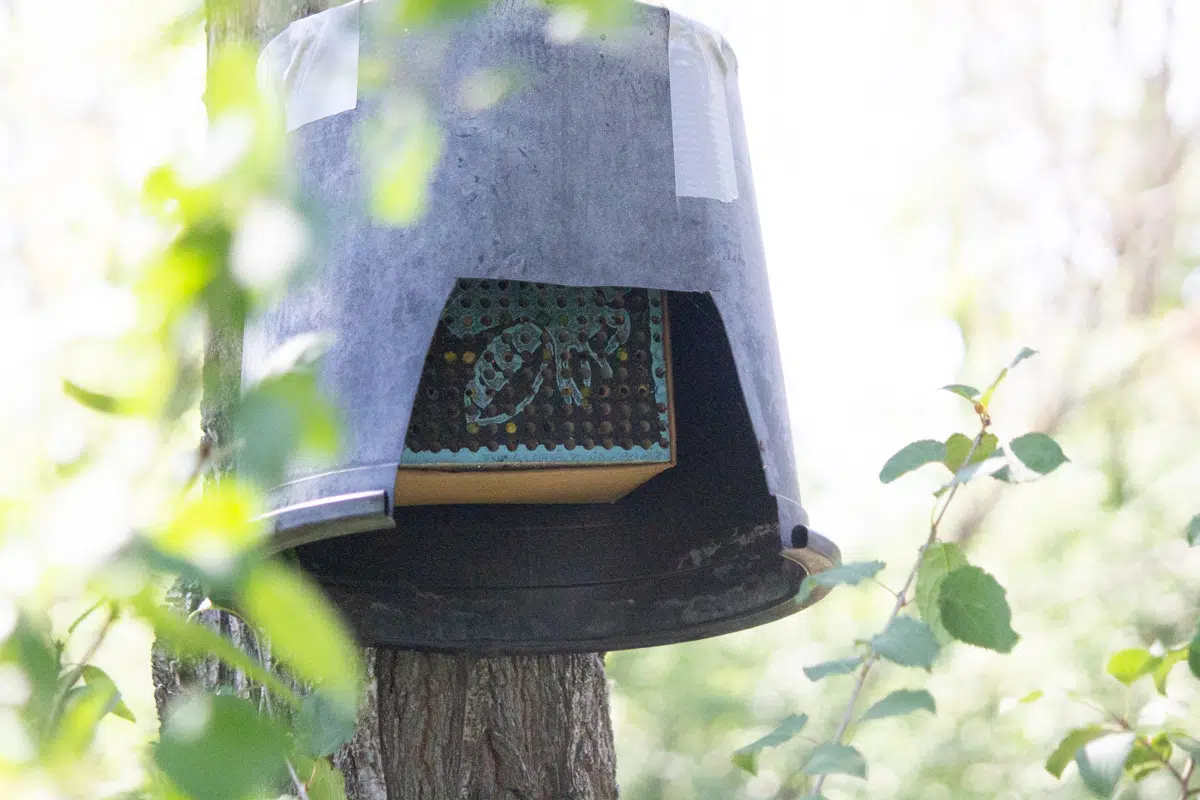Visitors to Regina’s Arboretum Park can pack a picnic and be joined by some of the Arboretum Park’s newest — and most hard-working — inhabitants.
Two nests of leafcutter bees have just settled into their new homes in the park in Wascana Centre.
“If you’re coming here and having lunch, maybe you’re having a picnic, you might see bees flying by and visiting because they like the sweetness of, say, fruit,” explained Sarah Romuld, an ecologist for the Provincial Capital Commission (PCC).
Leafcutters are a small bee that bear closer resemblance to a wasp. They also don’t make honey.
The bees get their name from the circular holes they bite, or cut, out of leaves that they then use to make nests.
Twelve new leafcutter bee habitats have been placed throughout Regina, with two of them in Arboretum Park. Two more are in the gardens at the First Nations University of Canada.
Rumold said ecologists decided to introduce this type of bee because they are native to the area and they are hard workers.
“They’re a small bee but they’re very efficient so they can visit thousands of different blossoms in one single day, which is very impressive,” she said.
Leafcutters, which are pollinators like their sister-insect the honey bee, are just one of several bee varieties, even within the park.
Pollinators, Rumold said, are extremely important to the health of plants like flowers and those that become the food consumed by humans.

Sarah Rumold, an ecologist for the Provincial Capital Commission, says one in three of the foods we eat are the result of pollinators like leafcutter bees. (Libby Giesbrecht/980 CJME)
“One out of three bites that you take is thanks to a pollinator,” Rumold said.
Leafcutters tend to stay within their foraging range, about 100 to 200 metres from their home.
Rumold said the bees have been spaced out in the park so they can be found almost anywhere.
At the end of the season, the homes of the bees will be cleaned and the bees will then go dormant until the next year.
While there will be some loss each season, Rumold said the hope is to have a continued leafcutter bee presence in the park for many seasons to come.
Leafcutters are known as a more docile type of bee. They do not have a queen, though they do enjoy living in a community.
While many people may approach bees with caution, fearful of being stung, Rumold said leafcutter bees are unlikely to harm people.
“Bees don’t have to be necessarily a scary thing at all,” Rumold said. “So long as you are staying away from their home, whether it be a nest, a hive … and you’re not angering them or disturbing them, should they be visiting a flower, you should pose no risk to them.”
Even while on a picnic, Rumold advised visitors to simply allow the bees to visit around them without disturbing them.
PCC park projects ongoing
The introduction of leafcutter bees is just one of several projects the PCC is working on currently in Arboretum Park.
Rumold called the introduction of the leafcutter bees a sort of pilot project that intersects with other work being done in the park for pollinators.
The PCC also recently released lady painter butterflies, also pollinators, and planted milkweed for monarch butterflies.
Pollinators span a variety of species, from animals like birds and bats to insects, including bees, wasps and butterflies.
Rumold said any pollinator will assist with taking care of the plants near their homes.
The Ground Conver Conversion project — or “bee turf” — is another initiative introduced by PCC. It involves converting tilled areas that have historically disrupted tree roots to areas with non-irrigated plants. These are good for areas with some shade and are ideal for insects.
The PCC is also seeking to reduce irrigation in the park to allow for more natural development.
“Part of that is seeking out areas that were irrigated before or we were doing things like tilling that weren’t in the best interest for the trees, for example, in that area,” Rumold explained.
“As opposed to tilling that area and keeping it free of weeds, we planted some seeds that are ideal for pollinators that will cover that area, keep it free from weeds and also we don’t have to irrigate.”
Other projects include the revitalization of display ponds and the addition of native prairie wildflowers to the area.
The Sprouts program is a new initiative for students in grades 3 and 4. After visiting Arboretum Park, students will take a plant back to their classroom to grow, such as grasses or trees.
Throughout the year, an expert will visit the class to help students raise the plant. In June, the classes will return to the park to help transplant their greenery.
Rumold said it is all about diversifying what is being planted and using a natural management style to care for their plants and pollinators.
An orchard is also opening in September by the current tree nursery. Fruit like apples and pears will be grown and visitors will be able to walk through the area and pick and eat the fruit.











